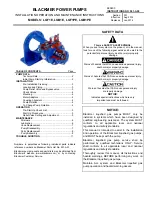
Page 42
EPS Stromversorgung GmbH
Alter Postweg 101 • 86159 Augsburg
Germany
Fon: +49 821 / 570451-0
Fax: +49 821 / 570451-25
www.eps-germany.de
PSI 10000 4U Serie
3.
Operation and application
3.1
Personal safety
•
In order to guarantee safety when using the device, it’s essential that only persons operate
the device who are fully acquainted and trained in the required safety measures to be taken
when working with dangerous electrical voltages
•
For models which can generate a voltage which is dangerous by contact, or is connected to
such, the included DC terminal cover, or an equivalent, must always be used
•
Whenever the load and DC output are being re-configured, the device should be disconnected
from the mains, not only the DC output switched off!
3.2
Operating modes
A power supply is internally controlled by different control circuits, which shall regulate voltage, current and power
to the adjusted values and hold them constant, if possible. These circuits follow typical laws of control systems
engineering, resulting in different operating modes. Each operating mode has its own characteristics which are
explained below in short form.
• Unloaded operation isn’t considered as a normal operation mode and can thus lead to false
measurements, for example when calibrating the device
• The optimal working point of the device is between 50% and 100% voltage and current
• It’s recommended to not run the device below 10% voltage and current, in order to meet
technical values like ripple or transient times
3.2.1
Voltage regulation / Constant voltage
Voltage regulation is also called constant voltage operation (CV).
The DC output voltage of a power supply is held constant on the adjusted value, unless the output current or the
output power according to P = U
OUT
* I
OUT
reaches the adjusted current or power limit. In both cases the device
will automatically change to constant current or constant power operation, whatever occurs first. Then the output
voltage can’t be held constant anymore and will sink to a value resulting from Ohm’s law.
While the DC output is switched on and constant voltage mode is active, then the condition “CV mode active” will
be indicated on the graphic display by the abbreviation CV and this message will be passed as a signal to the
analog interface, as well stored as status which can also be read as a status message via digital interface.
3.2.1.1
Transient time after load step
For constant voltage mode (CV), the technical date “Transient time after load step” (see
) defines a time that
is required by the internal voltage regulator of the device to settle the output voltage after a load step. Negative
load steps, i.e. high load to lower load, will cause the output voltage to overshoot for a short time until compensated
by the voltage regulator. The same occurs with a positive load step, i.e. low load to high load. There the output
collapses for a moment. The amplitude of the overshoot resp. collapse depends on the device model, the currently
adjusted output voltage and the capacity on the DC output and can thus not be stated with a specific value.
Depictions:
Example for neg. load step: the DC output will rise
above the adjusted value for a short time. t = transient
time to settle the output voltage.
Example for pos. load step: the DC output will collapse
below the adjusted value for a short time. t = transient
time to settle the output voltage.
















































